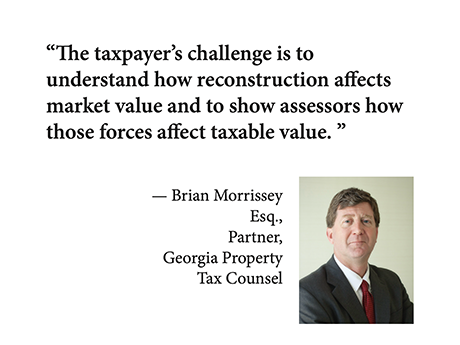The conversion of obsolete office buildings to new uses is a growing trend in many markets, especially in dense urban centers. Unfortunately, properties under reconstruction can continue to incur hefty property tax bills, even when the asset lacks a rent stream to help offset the owner’s costs.
The right arguments can help these taxpayers reduce their property tax liability during a building conversion, however, and set the stage for an accurate, fair assessment of the asset’s adjusted market value under its new use. The taxpayer’s challenge is to understand how reconstruction affects market value and to show assessors how those forces affect taxable value.
Obsolescence and opportunity
Demand for office space was already faltering when the COVID-19 pandemic accelerated occupancy declines. Since then, remote work and space sharing among office workers has further reduced the amount of offices companies need, with many tenants returning space to property owners as leases mature.
Normally, appraisers value multitenant office buildings under an income approach, attributing rental income per square foot as a starting point for valuation. When the space loses market viability, the per-square-foot rent variable declines and lowers the net valuation for tax purposes.
Expanding this result over an entire central business district can erode the tax base significantly as older buildings lose value. Many older properties struggle to compete with newer spaces, in addition to suffering from declining post-pandemic user demand. In essence, the older office towers were hampered by economic obsolescence.
Downtown office vacancy rates now exceed 25 percent in many major cities, dealing a significant blow to market value and, subsequently, tax value. Obviously, owners and city government share a common goal of maximizing property usage, which increases revenue to the owner and tax value to the government.
One solution gaining traction in markets with strong residential demand is converting obsolete office buildings to residential apartments or condominiums. This is a multistep process that can take considerable time, possibly spanning one or more tax years.
Investments in time
The first task in a conversion is to empty the building, an often protracted process that simultaneously reduces the property’s income and market value. Waiting for each lease to expire while revenue streams decline can be an expensive exercise. Taxpayers should ensure that the assessor has factored in this negative movement in the building’s value under the income approach. When few tenants remain, the owner may choose to buy out the remaining leases.
Reconstruction begins with demolishing building components that will not fit the future use. For example, suspended ceilings commonly used in office buildings are unsuitable for living spaces and would need to be removed.
While this phase can start before the building is completely empty, it cannot be finished until the building is unoccupied. During this period, the income generated is virtually zero and has a continued negative effect on the building’s market value and taxable value.
The project design will be partly determined by the local apartment market. Creating a product that will compete successfully for tenants has a direct impact on cost, finish work and amenity choices. During this stage, the owner is incurring costs without generating income from the property.
Because the building is as an empty space during conversion, income-based valuation methods no longer apply. Appropriate value would be that of an old, empty building that is economically obsolescent. Further, the value would be lower than when the building still had office tenants.
New beginnings
The building owner can begin to attract potential residents during the conversion. While tenants may sign leases, they will not be paying rent until the building has received a certificate of occupancy from local government.
This marketing period is an extension of the construction phase that could bring the start of a residential rent stream closer by having tenants lined up. This gives the owner a vision of future value and may also allow a return to the income approach to valuation by more clearly defining the property’s function.
Once the property is available for residential use, a different revenue stream will begin and grow as tenants lease the units. Clearly, taxpayers should make sure assessors apply the income approach as the building moves toward full occupancy. Residential units typically generate lower rent per square foot than office properties, but healthy occupancy will more than make up for the slight reduction from the asking rental rate on an obsolete office building in a declining market.
Usage conversion is a long and meandering trail that a property owner must travel before a new use can begin to generate revenue and a return on investment. By protesting tax assessments that fail to reflect the asset’s diminished value during this process, taxpayers can at least defend against an unfair tax burden.
The steps outlined here for transitioning from office to residential space have many moving parts and presuppose the owner has identified residential demand to support the new use. Many urban cores have experienced an uptick in urban living, however, and with the right circumstances, many old buildings can be converted for increased use. Consequently, while the process is time consuming, the net result may prove invaluable to the owner and taxing authority.
—Brian Morrissey is an attorney and partner at the Atlanta law firm Georgia Property Tax Counsel, the Georgia member of American Property Tax Counsel, the national affiliation of property tax attorneys. He can be reached at bmorrissey@rbspg.com.


